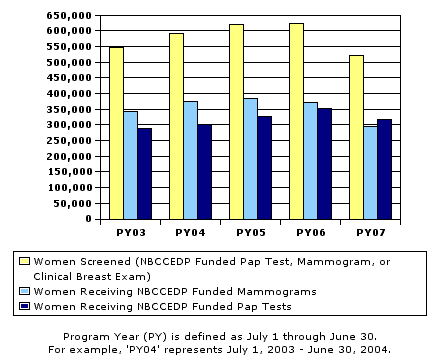|
|
||||||||||||||||
|
|
|
|
|
|||||||||||||
|
|
Control and Prevention Division of Cancer Prevention and Control 4770 Buford Hwy, NE MS K-64 Atlanta, GA 30341-3717 Call: 1 (800) CDC-INFO TTY: 1 (888) 232-6348 FAX: (770) 488-4760 E-mail: cdcinfo@cdc.gov Submit a Question Online |
|
|
|
About the ProgramDownload the 2008/2009 National Breast and Cervical Cancer Early Detection Program Fact Sheet (PDF-1.1MB). Through the National Breast and Cervical Cancer Early Detection Program (NBCCEDP), the Centers for Disease Control and Prevention (CDC) provides low-income, uninsured, and underserved women access to timely breast and cervical cancer screening and diagnostic services. To improve access to screening, Congress passed the Breast and Cervical Cancer Mortality Prevention Act of 1990, which guided CDC in creating the NBCCEDP. Currently, the NBCCEDP funds all 50 states, the District of Columbia, 5 U.S. territories, and 12 American Indian/Alaska Native tribes or tribal organizations to provide screening services for breast and cervical cancer. The program helps low-income, uninsured, and underinsured women gain access to breast and cervical cancer screening and diagnostic services. These services include:
In 2000, Congress passed the Breast and Cervical Cancer Prevention and Treatment Act, which gives states the option to offer women in the NBCCEDP access to treatment through Medicaid. To date, all 50 states and the District of Columbia have approved this Medicaid option. In 2001, with passage of the Native American Breast and Cervical Cancer Treatment Technical Amendment Act, Congress explained that this option also applies to American Indians/Alaska Natives who are eligible for health services provided by the Indian Health Service or by a tribal organization. Program EligibilityAn estimated 8%–11% of U.S. women of screening age are eligible to receive NBCCEDP services. Federal guidelines establish an eligibility baseline to direct services to uninsured and underinsured women at or below 250% of federal poverty level; ages 18–64 for cervical screening; ages 40–64 for breast screening. AccomplishmentsSince 1991, NBCCEDP-funded programs have served more than 3.2 million women, provided more than 7.8 million screening examinations, and diagnosed 35,090 breast cancers, 2,161 invasive cervical cancers, and 114,390 precursor cervical lesions, of which 42% were high-grade. Approximately 15.9% of NBCCEDP-eligible women aged 40–64 years are screened for breast cancer and 7.1% of eligible women aged 18–64 years are screened for cervical cancer through the program. In program year 2007, the NBCCEDP
These and other public health efforts that address breast and cervical cancer support CDC’s overarching goal of healthy people in every stage of life. They also address the U.S. Department of Health and Human Services' Healthy People 2010 goals of:
To reach underserved women, the NBCCEDP supports an array of strategies, including program management, screening and diagnostic services, data management, quality assurance and quality improvement, evaluation, partnerships, professional development, and recruitment. Providers in the program work collaboratively to provide breast and cervical cancer screening, diagnostic evaluation, and treatment referrals (where appropriate). The program's continued success depends in large part on the complementary efforts of a variety of national organizations, as well as on state and community partners. Screening Deaths from breast and cervical cancers could be avoided if cancer screening rates increased among women at risk. Deaths from these diseases occur disproportionately among women who are uninsured or underinsured. Mammography and Pap tests are underused by women who have no source or no regular source of health care, women without health insurance, and women who immigrated to the United States within the past 10 years.1 July 2002 to June 2007 National Aggregate 
Future DirectionsThe Program Services Branch (PSB) of CDC's Division of Cancer Prevention and Control administers the NBCCEDP and is engaged in strategic planning to set directions and priorities for the future. Achieving program efficiency and effectiveness will continue to be high priorities. VISION: Healthy women living cancer-free. MISSION: To lead and support breast and cervical cancer screening to save lives. GOALS:
*Environmental factors are issues that may impact the ability of the PSB to achieve its mission. They include potential reimbursement for more costly new technologies, trends in health care reform and universal coverage, recent evidence of population declines in mammography rates, and increases in the eligible population due to a rise in the number of uninsured women and an aging population. Reference1Pleis JR, Schiller JS, Benson V. Summary health statistics for U.S. adults: National Health Interview Survey, 2000. Vital and Health Statistics. Series 10, Data from the National Health Survey. 2003;(215):1–132.
Page last reviewed: January 12, 2009
Page last updated: January 12, 2009 Content source: Division of Cancer Prevention and Control, National Center for Chronic Disease Prevention and Health Promotion |
|
|||||||||||||||||||||||||||||||||||||||||||||||||||||||||
|
|
|
||||||||||||
|